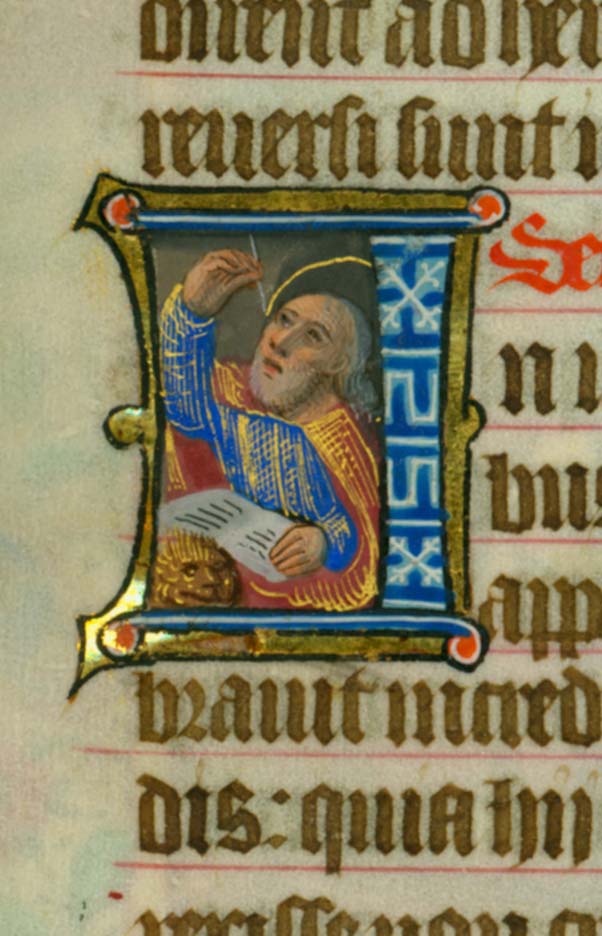On the Archives & Rare Books website, we try to keep it fresh by putting up new images from time to time, especially our banner pictures. All of them are taken from our various holdings and we often get queries about what they are exactly, what collections they’re from, what era they represent, and the like. Lately, we’ve received several about our banner image of St. Mark. The painting of the gospel writer is from our book of hours, what we call the Limoges Book of Hours, but is listed in UCLID as Ms. No. 37.
 Created ca. 1475 in a monastic workshop in Limoges, France, this book of hours is written on vellum and bound in velvet. There are exquisite illuminated pages throughout the volume illustrating events like the Conception and the Resurrection. As with all books of hours from the Middle Ages to the Renaissance, the volume contains the prayers read at the designated times of day, along with a list of saints and feast days important to the region in which the book was made. Additionally, most books of hours contain the four Gospels of Matthew, Mark, Luke, and John. And this is where St. Mark comes in. Each evangelist often was depicted with a symbol associated with that saint in Christian iconography. Matthew’s symbol is often an angel, Luke is accompanied by an ox, and John by an eagle. The angel represents human nature and salvation, the ox means strength and service, and the eagle denotes eternity and the sacred nature of Christ.
Created ca. 1475 in a monastic workshop in Limoges, France, this book of hours is written on vellum and bound in velvet. There are exquisite illuminated pages throughout the volume illustrating events like the Conception and the Resurrection. As with all books of hours from the Middle Ages to the Renaissance, the volume contains the prayers read at the designated times of day, along with a list of saints and feast days important to the region in which the book was made. Additionally, most books of hours contain the four Gospels of Matthew, Mark, Luke, and John. And this is where St. Mark comes in. Each evangelist often was depicted with a symbol associated with that saint in Christian iconography. Matthew’s symbol is often an angel, Luke is accompanied by an ox, and John by an eagle. The angel represents human nature and salvation, the ox means strength and service, and the eagle denotes eternity and the sacred nature of Christ.
For Mark and his accompanying symbol of the lion, the representation is of courage, the concept of Christ as king, and salvation. Our image of him shows the lion in the lower left corner and Mark, clad in gold, red, and blue, is looking toward heaven and writing down the divinely-inspired words of his gospel. Mark, along with the other three evangelists, is painted in a historiated initial. Decorated initials abound throughout the book of hours, leading off sentences and paragraphs. Historiated initials differ in that while they are certainly decorated letters, they also contain a picture of a figure that relates to the entire story or account. These types of initials in illuminated manuscripts date to the 8th century. The legacy of these letters, especially decorated initials, is still evident today, more than a millennium later. As we have moved from calligraphic manuscripts to moveable type to electronic texts, these enhanced initials signify chapter beginnings and important documents.
To learn more about the holdings of the Archives & Rare Books Library, please contact us at 513.556.1953; by email, archives@ucmail.uc.edu; or on the web at http://www.libraries.uc.edu/arb.html.
